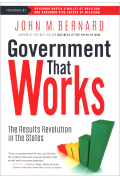The Public Manager Magazine Article
Cutting Through Government Complexity
Government That Works: The Results Revolution in the States shows how a lean management approach can be applied to government.
Thu Sep 10 2015

"Modern American government has evolved into the most complex societal enterprise in the history of mankind," writes John Bernard. There are 22 million government employees; 89,004 unique government entities; and an infinite number of federal laws and regulations (with thousands more being added each year) that no reliable source can begin to count. The U.S. government is indeed a "monster of complexity."
In Government That Works, Bernard shows how a lean management approach can be applied to government, in which every employee—no matter his or her level—is responsible for identifying and eliminating anything that does not add value to citizens.
Stripped to its bones, Bernard's plan looks like this:
listen to customers and employees
collect and analyze accurate data
set goals for improved performance
measure progress toward those goals—and make the whole process transparent to the public.
But the plan only works if individual employees are empowered to enact solutions that reintroduce simplicity to government. "People want to solve problems with grit and imagination," Bernard writes. Inefficient processes (and being powerless to fix them) result in low employee morale and high turnover, which contribute to overall ineffectiveness.
Bernard blames government inefficiency and waste on a very primal element: fear. Fear of being exploited, fear of repercussions for overstepping one's boundaries, fear of negative exposure by the media. In chapter 2, Bernard quickly sketches the evolution of government complexity—a picture that will be instantly familiar to any longtime government employee. Then, using several case studies of government organizations, he shows how transparency and accountability (and a shift in focus from process to results) can make drastic improvements to our current systems.
For example, Bernard shows how Washington Governor Jay Inslee and his team implemented Results Washington when Inslee took office. The initiative was designed to help Washington's government drive more and better results. The steps involved identifying strategic goals, establishing teams around those goals, building "goal maps," and scheduling periodic meetings with the governor to review progress.
Bernard emphasizes the importance of accountability tools, such as goal maps, dashboards, and scorecards, in results-driven government. The book includes a "Fundamentals Map" created by the Oregon Youth Authority that clearly shows the agency's mission and goals, as well as how each employee is accountable for achieving those goals. The map cuts through the complexity typical of government agencies, keeping everyone focused on the most important tasks.
Also discussed are the scorecards used by Maryland's government to measure progress toward the state's goals, and dashboards used by organizations such as the City of Seattle and the Texas Education Agency to capture and make sense of relevant data.
Finally, the last few chapters focus on what individual government employees can start doing today to introduce more simplicity, accountability, and transparency in their agencies. For employees frustrated with the complexity and senselessness that often plagues our government, Government That Works is an empowering, valuable read.
